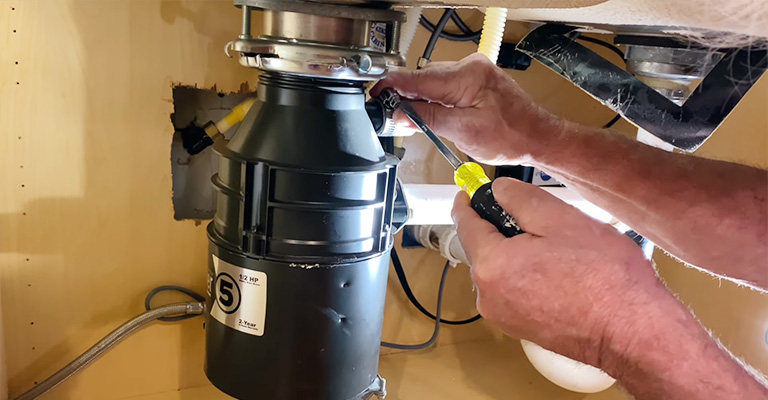Are you tired of opening your dishwasher after a cycle only to find it filled with dirty, soapy water that came from your sink?
Sinks that drain into dishwashers pose many problems, including leaks from the dishwasher overflow and/or water backed up in the sinks, as well as overflows.
The bigger issue is that you have a potential health hazard besides having to mop out. It is not a good idea to leave dirty sudsy water in your sink or dishwasher.
A dishwasher that has sink water flowing into it could not only cause bad odors in the kitchen, but could also pose a health risk, so it needs to be addressed as soon as possible.
This can happen due to the fact that the main line of the sink and dishwasher are connected – any issue with that line can result in a backup.
It may be possible to avoid this with some cleaning and preventative maintenance. There are times when you will need the services of a plumber. We’ll explore what’s causing these issues and how you can resolve them.
Troubleshooting Water Everywhere Down the Sink and into the Dishwasher
You’ve got a problem when your kitchen sink drains into your dishwasher. There is also the possibility of an overflow leak from the dishwasher and/or back-up of water onto the sink.
You’re not just mowing out a mess, you’re also potentially exposed to a health hazard. The last thing you want in your sink or dishwasher is dirty sudsy water filled with bacteria.
Water from the sink flowing into the dishwasher can not only cause bad smells in your kitchen, but it’s also a health risk, so you should address this problem as soon as you notice it.
This happens because the main line connecting the sink and dishwasher is the same, so any problem there can cause a backup.
Often, preventative maintenance and a little cleaning will prevent this from happening. There are times when you’ll need a plumber.
Check out what’s causing these problems and how you can fix them. When sink water drains into the dishwasher, there are several areas to check.
Sink and Dishwasher Maintenance 101
To minimize your risk of electric shock and injury, unplug your appliances (dishwasher, garbage disposal, etc.) before cleaning or fixing your plumbing problems.
Prevent any water flow to your appliances by shutting off both the cold and hot water supply valves.
Additionally, it is important to know that the drainage lines from both your dishwasher and kitchen sink are the same.
This means that any blockage or clog in your kitchen sink’s main drainage line can result in water backing up and overflowing.
There are four places where clogs usually occur: the dishwasher, the garbage disposal, the sink, and the air gap. You can have water filling up your sink when your dishwasher is clogged at any of these four points in your plumbing system.
It is basically possible to cause sink water to drain into your dishwasher through a couple of different sources:
1. Kitchen Sink Clogged Drain
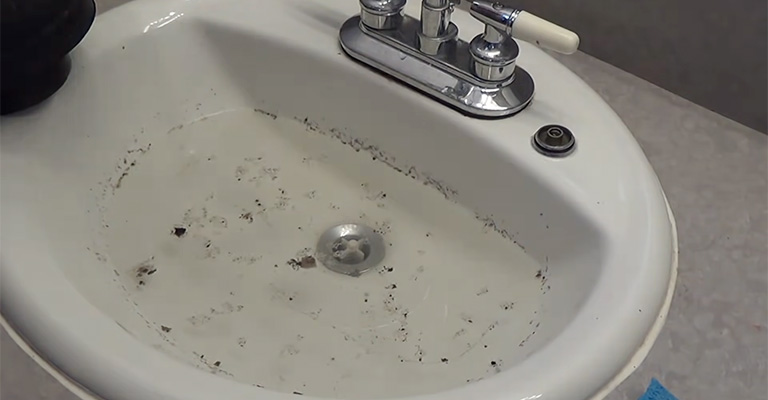
There are a lot of food and food byproducts that wash down kitchen sinks, including fiber and grease. Clogged drains can happen frequently, sometimes over time.
Water pressure in the pipes can increase when there is a clog in the line, pushing sink water up into the dishwasher drain.
The sink trap (P trap) underneath the sink can be disconnected and the blockage removed to relieve the pressure.
The waste pipe leading into the wall behind the sink may not be clogged there. If it is not, run a snake through the waste pipe. Water and clogged material will come pouring out, so you’ll need a bucket to catch them.
To remove clogged material from the waste line, plunge the sink drain next to the waste line to break it up.
There is, however, one caution to be aware of. Plungers greatly increase the pressure in the line, therefore defeating the air gap, even if no backflow has occurred.
It is important that the dishwasher drain hose is clamped shut where it meets the sink’s drainage system.
2. Garbage Disposal
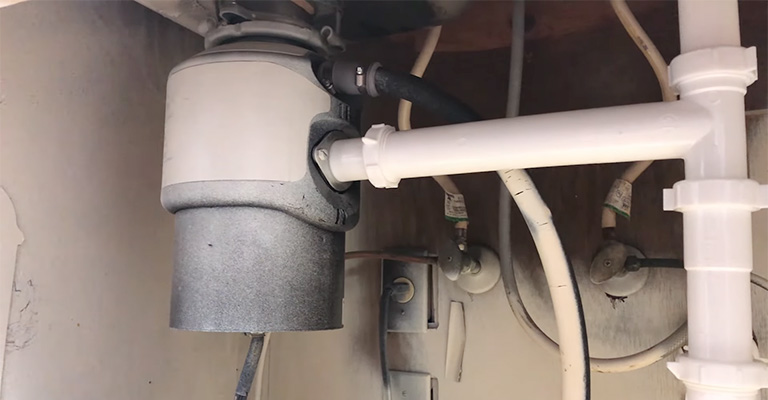
Someone may have left the plug in a port where the dishwasher drain line connects to the disposal if you have a new garbage disposal and wastewater is backing up into the dishwasher.
You may not realize how often this happens. It’s something we see a lot. The first thing you need to do is unplug the disposal from the electricity. Make sure you don’t mix water and electricity!
On the side of the disposal unit, remove the rubber drainage plug. With a screwdriver, look inside the port for a plastic plug. It is possible to resolve the draining problem by removing one if you find one.
A clogged garbage disposal, or one that doesn’t seem to have a plug, could be causing waste water from the dishwasher to return to the dishwasher if there is no plug or if the garbage disposal is not that new.
If the strainer is not cleaned regularly, this can happen. If you don’t properly flush the disposal after turning it on and put too much food waste into it, it may get clogged.
3. Dishwasher Drain Line Clog
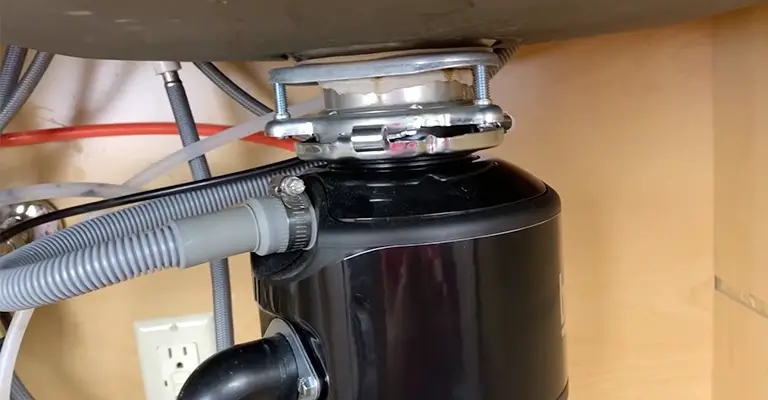
Perhaps sink water backflow into the dishwasher originated in the dishwasher line, rather than the kitchen sink. If there are no other clogs, this should be suspected.
There is a possibility that food debris and grease from dishes can pass through the strainer at the bottom of the dishwasher and build up into sticky clumps that clog the drain lines.
When the dishwasher pumps wastewater out, it hits a clog and flows back in. You must loosen the drain hose clamps to remove it, then run a strong stream of water through it until it is clear.
Make sure the dishwasher strainer is also clean. For periodic cleaning, we can easily remove the strainer from the dishwasher’s floor. Check beneath the strainer to see if any gunk got through.
With your fingers, you should be able to remove the gunk. The question of whether dishes should be rinsed before going into the dishwasher is of course discussed in many households.
If you have experienced a clog like this one, you may think you should rinse. It is also possible for accumulated grease and food to cause a sink drain clog.
Those who oppose pre-rinsing claim that modern dishwashers are strong enough to handle even dirty dishes without needing pre-rinsing.
Clearly, we know which is correct. You should follow your spouse’s opinion.
4. Drain Hose Air Gap
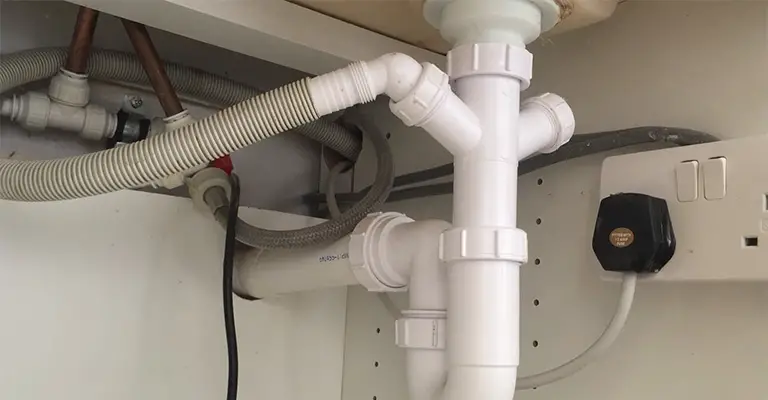
Dishwasher drain hoses with air gaps prevent dirty sink water from flowing back into dishwashers by creating a section of air in the loop.
The faucet closest to the dishwasher usually has a silver cylinder attached to the rim of the sink.
Backflow into the dishwasher could indicate that your dishwasher’s hose has a damaged air gap, and it must be replaced.
The air gap could also be being surpassed by pressure caused by a clog further down. If this is the case, you must find the cause of the clog.
5. Drain Hose Loop
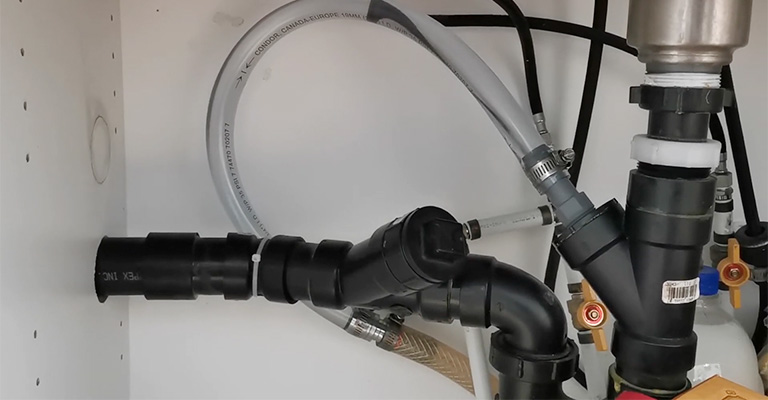
There may have been a problem installing the dishwasher drain hose, or it may have been accidentally pulled down to a lower center of gravity. Drain hose loops are the first thing you should check.
A drain hose attaches to either the kitchen sink drain or to the garbage disposal, starting at the bottom of the dishwasher and looping up to a higher point.
The loop prevents water from draining back into the dishwasher from the kitchen sink. Backflow is prevented by the loop because gravity follows water.
The dishwasher drain hose loop sends the water “uphill” into the sink or garbage disposal, which is driven by a pump.
Consequently, why would the loop drain sink water into the dishwasher if it is designed to prevent it from happening? There is often an exposed drain hose under the kitchen sink cabinet.
It is possible that the loop will fall below where the sink or disposal is connected, especially if it was not properly secured when it was first installed.
As a result, water from the sink will eventually find its way into the dishwasher drain hose and flow into the dishwasher.
Quick fix: Put the loop in the sink base cabinet at a high enough point above the dishwasher’s water level so it doesn’t move.
Preventative Maintenance
It is possible to prevent clogs that could lead to sink water draining into your dishwasher by doing a few things. Before you wash dishes (either in the sink or the dishwasher), scrape off any food that has been on them.
Dispose of cooking grease in a separate container instead of down the drain. Don’t forget to clean the dishwasher drain on a regular basis.
Use only as much dishwashing detergent as is recommended, as too much detergent residue can clog the drain.
When To Call In A Plumber?
It should be fairly easy to clear a clog that’s causing sink water to drain into your dishwasher if you have a few basic DIY skills. Perhaps.
Think twice before you crawl under a sink, especially if you don’t feel comfortable with tools. How handy are you, really?
There are many frustrating tasks that a DIY homeowner may encounter when trying to fix a clogged drain, incorrectly installed garbage disposal, or misrouted dishwasher drain hose.
More than our fair share of DIY projects gone wrong have cost homeowners more than they would have paid if they had hired a plumber instead.
Final Words
The dishwasher filling up your sink is certainly an unpleasant and inconvenient experience, though it is not the worst plumbing problem you could encounter.
A simple cleaning and occasional maintenance can often fix and prevent this type of recurring problem.

